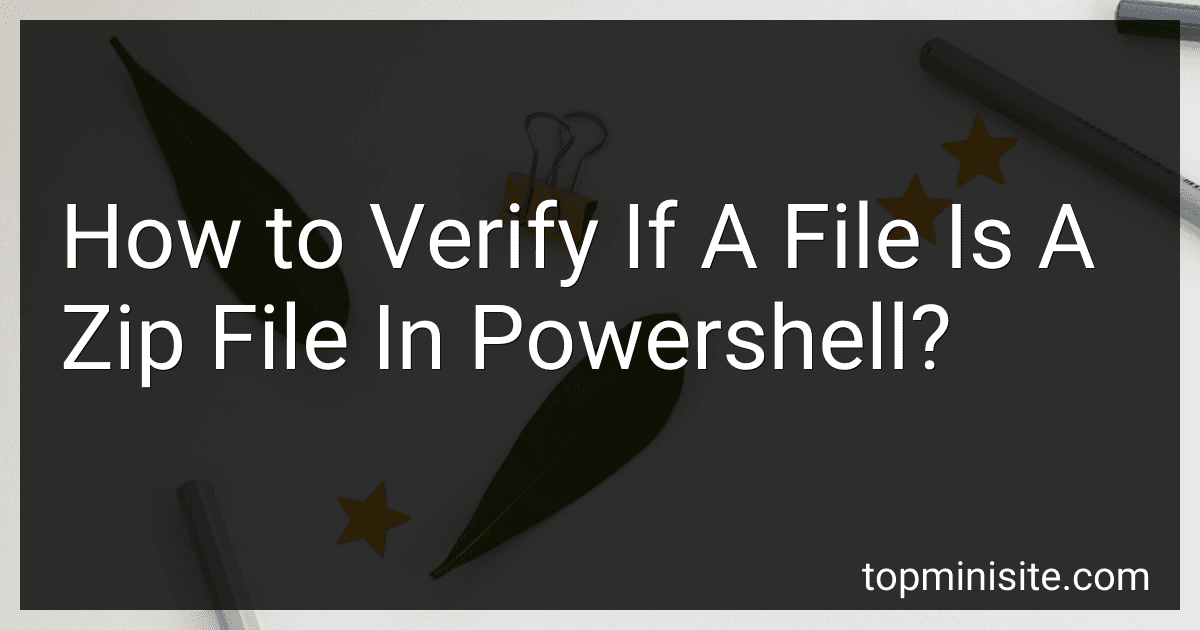Posts (page 61)
-
 5 min readTo limit rows in a pandas dataframe, you can use the following methods:Use the head() method to return the first n rows of the dataframe. For example, df.head(10) will return the first 10 rows of the dataframe. Use the tail() method to return the last n rows of the dataframe. For example, df.tail(5) will return the last 5 rows of the dataframe. Use slicing to select a specific range of rows. For example, df[5:10] will return rows 5 to 9 of the dataframe.
5 min readTo limit rows in a pandas dataframe, you can use the following methods:Use the head() method to return the first n rows of the dataframe. For example, df.head(10) will return the first 10 rows of the dataframe. Use the tail() method to return the last n rows of the dataframe. For example, df.tail(5) will return the last 5 rows of the dataframe. Use slicing to select a specific range of rows. For example, df[5:10] will return rows 5 to 9 of the dataframe.
-
 3 min readIn PowerShell, a 2D array can be created by defining an array of arrays. Each element in the array represents a row, and each row contains multiple columns of data. To create a 2D array, you can use the following syntax:$my2DArray = @( @(1, 2, 3), @(4, 5, 6), @(7, 8, 9) )This will create a 2D array with 3 rows and 3 columns.
3 min readIn PowerShell, a 2D array can be created by defining an array of arrays. Each element in the array represents a row, and each row contains multiple columns of data. To create a 2D array, you can use the following syntax:$my2DArray = @( @(1, 2, 3), @(4, 5, 6), @(7, 8, 9) )This will create a 2D array with 3 rows and 3 columns.
-
 6 min readTo grab specific JSON nested values in PowerShell, you can use the ConvertFrom-Json cmdlet to convert the JSON data into a PowerShell object. Once you have the JSON data as an object, you can access the nested values by using dot notation or by navigating through the object's properties and keys. You can also use the Select-Object cmdlet to filter and retrieve specific nested values from the JSON data.
6 min readTo grab specific JSON nested values in PowerShell, you can use the ConvertFrom-Json cmdlet to convert the JSON data into a PowerShell object. Once you have the JSON data as an object, you can access the nested values by using dot notation or by navigating through the object's properties and keys. You can also use the Select-Object cmdlet to filter and retrieve specific nested values from the JSON data.
-
 5 min readTo create a custom array in PowerShell, you can simply initialize a variable with an array of elements. For example, you can create an array of numbers like this: $myArray = @(1, 2, 3, 4, 5) You can also create an array of strings or any other data type by simply enclosing the elements in parentheses and separating them with commas.Custom arrays allow you to store and manipulate groups of values easily in PowerShell.
5 min readTo create a custom array in PowerShell, you can simply initialize a variable with an array of elements. For example, you can create an array of numbers like this: $myArray = @(1, 2, 3, 4, 5) You can also create an array of strings or any other data type by simply enclosing the elements in parentheses and separating them with commas.Custom arrays allow you to store and manipulate groups of values easily in PowerShell.
-
 3 min readIn PowerShell, you can verify if a file is a zip file by using the following command: $filePath = "path/to/your/file.zip" $signature = 0x504B0304 $bytes = [System.IO.File]::ReadAllBytes($filePath) $fileSignature = [BitConverter]::ToUInt32($bytes, 0) if ($fileSignature -eq $signature) { Write-Output "The file is a zip file." } else { Write-Output "The file is not a zip file.
3 min readIn PowerShell, you can verify if a file is a zip file by using the following command: $filePath = "path/to/your/file.zip" $signature = 0x504B0304 $bytes = [System.IO.File]::ReadAllBytes($filePath) $fileSignature = [BitConverter]::ToUInt32($bytes, 0) if ($fileSignature -eq $signature) { Write-Output "The file is a zip file." } else { Write-Output "The file is not a zip file.
-
 3 min readTo get types from an F# assembly using PowerShell, you can use the Add-Type cmdlet to load the assembly into your session. Once the assembly is loaded, you can use the Get-ChildItem cmdlet to explore the types contained within the assembly. You can also use the Get-Member cmdlet to inspect the properties and methods of each type. Additionally, you can use the New-Object cmdlet to create instances of the types within the assembly and interact with them programmatically.
3 min readTo get types from an F# assembly using PowerShell, you can use the Add-Type cmdlet to load the assembly into your session. Once the assembly is loaded, you can use the Get-ChildItem cmdlet to explore the types contained within the assembly. You can also use the Get-Member cmdlet to inspect the properties and methods of each type. Additionally, you can use the New-Object cmdlet to create instances of the types within the assembly and interact with them programmatically.
-
 3 min readTo ignore or convert "\n" in a CSV file using Pandas, you can read the file into a Pandas DataFrame and then manipulate the data accordingly. One way to handle "\n" characters is by using the replace() method to replace them with an empty string or any other desired character.You can read the CSV file into a DataFrame using the read_csv() function in Pandas: import pandas as pd df = pd.read_csv('file.
3 min readTo ignore or convert "\n" in a CSV file using Pandas, you can read the file into a Pandas DataFrame and then manipulate the data accordingly. One way to handle "\n" characters is by using the replace() method to replace them with an empty string or any other desired character.You can read the CSV file into a DataFrame using the read_csv() function in Pandas: import pandas as pd df = pd.read_csv('file.
-
 5 min readIn PowerShell, the Format-Table cmdlet is used to display output in a tabular format. To enumerate a specific entry in the formatted table output, you can use the Select-Object cmdlet along with the index of the desired entry.For example, if you have a command that outputs a table with multiple entries and you want to select a specific entry, you can first store the output in a variable and then use Select-Object with the index of the desired entry.
5 min readIn PowerShell, the Format-Table cmdlet is used to display output in a tabular format. To enumerate a specific entry in the formatted table output, you can use the Select-Object cmdlet along with the index of the desired entry.For example, if you have a command that outputs a table with multiple entries and you want to select a specific entry, you can first store the output in a variable and then use Select-Object with the index of the desired entry.
-
 4 min readTo access single columns in pandas using a for loop, you can iterate over the column names and then use the column name to extract the column data. You can do this by first getting the list of column names using df.columns, and then iterating over each column name to access the column data using df[column_name].
4 min readTo access single columns in pandas using a for loop, you can iterate over the column names and then use the column name to extract the column data. You can do this by first getting the list of column names using df.columns, and then iterating over each column name to access the column data using df[column_name].
-
 3 min readTo convert a string to an integer in PowerShell, you can use the [int] type accelerator followed by the string variable or value you want to convert. For example, you can use $integerVariable = [int]"123". This will convert the string "123" to an integer value and store it in the variable $integerVariable.[rating:69124b1f-7719-4c02-b18b-990e9c9271ea]What is the command to convert a string to an integer in Powershell.
3 min readTo convert a string to an integer in PowerShell, you can use the [int] type accelerator followed by the string variable or value you want to convert. For example, you can use $integerVariable = [int]"123". This will convert the string "123" to an integer value and store it in the variable $integerVariable.[rating:69124b1f-7719-4c02-b18b-990e9c9271ea]What is the command to convert a string to an integer in Powershell.
-
 5 min readTo convert JSON data from a URL into a pandas dataframe, you can use the json() method of the requests library to fetch the JSON data from the URL. Then you can use the pandas library to read the JSON data into a dataframe using the pd.read_json() function. Make sure to handle any errors that may occur during the process, such as network connectivity issues or invalid JSON data.
5 min readTo convert JSON data from a URL into a pandas dataframe, you can use the json() method of the requests library to fetch the JSON data from the URL. Then you can use the pandas library to read the JSON data into a dataframe using the pd.read_json() function. Make sure to handle any errors that may occur during the process, such as network connectivity issues or invalid JSON data.
-
 4 min readTo save URL output into a file in PowerShell, you can use the "Invoke-WebRequest" cmdlet to fetch the content of the URL, and then use the ">" operator to redirect the output to a file. Here's an example of how to do it: $webContent = Invoke-WebRequest -Uri "https://www.example.com" $webContent.Content > "output.txt" In this example, the content of the URL "https://www.example.
4 min readTo save URL output into a file in PowerShell, you can use the "Invoke-WebRequest" cmdlet to fetch the content of the URL, and then use the ">" operator to redirect the output to a file. Here's an example of how to do it: $webContent = Invoke-WebRequest -Uri "https://www.example.com" $webContent.Content > "output.txt" In this example, the content of the URL "https://www.example.